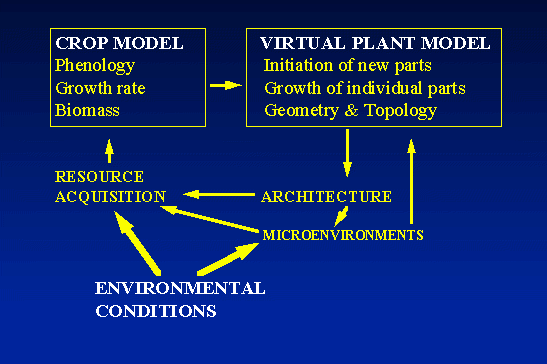Original URL: http://www.ctpm.uq.edu.au/virtualplants/ipivp.html
![]()
"Virtual plants" are computer simulations of the structural development and growth of individual plants in 3-D space. They are tools for plant scientists and teachers in fields as diverse as developmental biology, agronomy, ecology and pest management. The approach uses rules of development expressed as L-systems which are closely related to fractals. Complexity and other emergent properties arise when the rules are applied recursively, the output of one iteration becoming the input for the next. The approach is an example of computers providing a new way of achieving the major goal of science to show how complexity and apparent chaos can be compressed into, and regenerated from, simple rules.
A virtual plant is generated from a model which contains rules for the formation of new plant parts and for changes in size and shape of existing parts. As well as structural development and growth, the rules may represent processes such as wilting, compensation for damage, etiolation, tropisms, physical degeneration, senescence and abscission. They may be restricted to the dynamics observed in a constant environment or may incorporate responses triggered by environmental conditions. A virtual plant may simulate a whole plant or parts of a shoot or root system. It may represent a single real plant whose morphogenetic rules have been derived from measurements, the average of several real plants, or a hypothetical plant. Multiple virtual plants may be generated simultaneously to explore 3-D spatial phenomena involving members of a stand.
The architectural attributes of a virtual plant can be output as numbers, positions, sizes, surface areas, angles of attachment, ages and topological connections etc. of different plant parts. If the host computer has the necessary graphics, these attributes can also be summarised as realistic or schematic images or as animations simulating time lapse photography.
A virtual plant is NOT just a computer-generated image. Such an image is 'a' model in the sense of being a representation of a plant at particular instant but it is not 'the' virtual plant model which generates a sequence of developmental stages over time.
Virtual plants are not restricted to simulating what can be seen from the outside of plants. They can incorporate any measured or hypothetical process which is influenced by plant architecture. For example, movements of metabolites, hormones, induced defensive chemicals, systemic pathogens or systemic pesticides can be simulated in relation to morphogenesis and visualised as false colours or symbols. Independent simulations of external processes can be interfaced with virtual plants to represent the arrival of light, pathogens, damage or pesticides or the movement of insects over plant surfaces.
It is not intended to duplicate large parts of existing crop models by including significant physiology in virtual plant models. Rather, a generic interface is being developed to allow physiological models and virtual plant models to complement one another as suggested below:

Virtual plant and insect models are being built from 3-D digitiser measurements of real plants in research by the Spatial Dynamics of Insect-Plant Interactions Project of CSIRO Entomology and the Insect-Plant Interactions Program of the Centre for Tropical Pest Management. Data acquisition and processing software was written in these projects and simulations are being run using the Virtual Laboratory software developed by collaborators at the University of Calgary, Canada.
More references and related WWW sites.
![]()